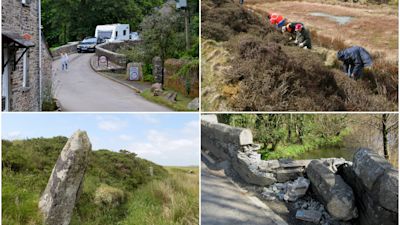More than 70 South West heritage sites added to Historic England's 'At Risk' list

More than 70 historic landmarks across the South West have been added to Heritage England's annual 'at risk' register.
The 2020 'Heritage At Risk' register identifies sites of historic importance that could be lost forever as a result of neglect, decay or inappropriate development.
There are now 1441 in the region under threat, with more than 700 of those across Devon and Cornwall.
Helland Bridge, Cornwall - added
Helland Bridge was built in the 15th century, spanning the River Camel.
Its carriageway is less than three metres wide and was not built for modern traffic - it has now been added to the Register because of the frequent damage from vehicles.
Trekelland Bridge, Cornwall - added
Trekelland Bridge is a late medieval bridge and carries the main road between Launceston and Liskeard over the River Inney.
Like Helland, it has been damaged by modern vehicles and has been deemed 'At Risk' by Heritage England.
Church of St Nicholas, Westgate Street, Gloucester
This large church was built around 1190 and was largely rebuilt in the 13th century, keeping some of its original features.
In 1643, during the Siege of Gloucester in the Civil War, the spire suffered a direct hit by cannon fire.
It was reduced in height and capped in 1783 and then declared redundant on 7 May 1971. The roof needs urgent structural repair.
In this year's list, 18 places of worship in the region are identified as under threat. Eleven of these are in Somerset - all have had lead stolen from their rooves.
At St Edward King & Martyr in Goathurst, near Bridgwater, lead was stolen from a 16th century chapel of which contains fine tombs. There are plans to re-roofed it with stainless steel.
Due to the current Covid-19 restrictions Heritage England was only able to assess sites and collect data where it was safe to do so, for this year's list.
Read more: Cheltenham's lido and Bristol shipwreck added to National Heritage List 2019
Read more: Historic England asks people in the South West to share their experience of coronavirus lockdown
It is not all doom and gloom, though. 53 sites in the West Country have been saved in the past year (2019-2020) and removed from the register.
Historic England said, "Over the last year, 53 buildings and sites in the South West have been saved thanks to the determination of local communities, charities, owners, local councils and Historic England, who together want to see historic places restored and brought back to life."
Some of the sites saved from the Heritage At Risk Register:
Clovelly Dykes, Devon
Clovelly Dykes is one of the largest hillforts in Devon.
Its deep ditches and steep rampart are challenging to manage - it has been on the At Risk Register for years due to the impact of damaging vegetation, scrub, trees and bracken.
With this now cleared and under control, Clovelly Dykes hillfort has been removed.
The site, however, remains closed to the public.
Elizabethan House, Plymouth
The Elizabethan House in New Street on Plymouth Barbican was built in the 1590s as part of the expansion of the city around Sutton Harbour.
After the First World War the area was earmarked for demolition, however it was saved by a number of supporters.
Repairs began in 1929 and the house re-opened as a museum but almost 90 years later, some of those repairs had deteriorated.
The building was then added to Historic England’s Heritage at Risk Register, but thanks to Historic England's repairs, the building is another to be removed from this year's list.
Cadbury Castle, Somerset
Probably best known for its associations with Arthurian legend - believed by many to be the lost Camelot - Cadbury Castle is loved by its many visitors.
Since the late 19th century, changes in the management of the land have led to a thick, impenetrable layer of invasive vegetation on all sides. Problems also include heavy erosion.
In the past three years Historic England has worked with the owner to clear most of it, revealing for the first time in decades the prehistoric access route to the camp and the fortified Iron Age entrance.
This year's list is published against a backdrop of challenging times for the region's heritage as a result of the coronavirus crisis. Historic England said our historic places have provided an anchor for communities in the face of the pandemic.
Duncan Wilson, chief executive of Historic England, said: "In testing times such as these, heritage can give us a sense of continuity and bring us solace. We also know that investing in historic places can help boost our economic recovery. "
READ MORE: